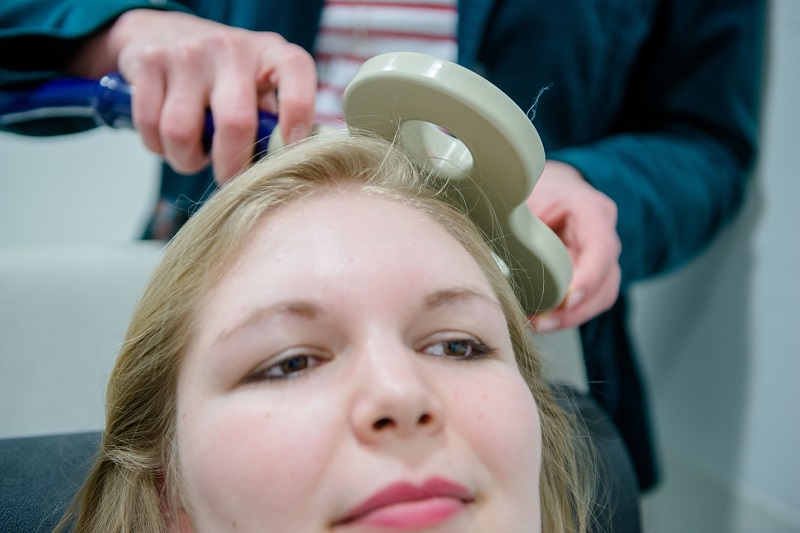
A06 –Testing for causality of fear extinction: Networks, plasticity, and beyond
Michael Nitsche, Fatemeh Yavari
In this project we will explore the specific interaction between the anterior network (hippocampus, amygdala, prefrontal cortex) and the cerebellum during extinction (study 1), develop non-invasive brain stimulation protocols suited for targeted modulation of extinction-relevant areas identified in that study (study 2), apply these to explore the causality of respective physiological interactions for extinction (study 3), and reveal cellular mechanisms of respective target structures for extinction by combining pharmacology (relevance of serotonin) and stimulation (study 4).
Guiding questions of A06:
- Does the cerebellum interact with anterior parts of the extinction network with regards to synchronization of activity, including oscillatory activity, during fear extinction?
- What is the specific role of intrinsic cerebellar versus cerebellar-anterior network interactions during fear extinction- true interaction or modulatory role of the cerebellum?
- Does intervention with non-invasive brain stimulation of respective target areas combined with serotonergic enhancement result in optimized fear extinction due to plasticity modulation?

10 project-relevant publications
Batsikadze G, Rezaee Z, Chang DI, Gerwig M, Herlitze S, Dutta A, Nitsche MA, Timmann D (2019) Effects of cerebellar transcranial direct current stimulation on cerebellar-brain inhibition in humans: A systematic evaluation. Brain Stimul 12(5):1177–1186. https://doi.org/10.1016/j.brs.2019.04.010
Chhabra H, Ma Y, Genç E, Nitsche MA, Yavari F (2025) The physiological foundation of extinction improvement by tDCS over the ventromedial prefrontal cortex (vmPFC): An fMRI study. SSRN: abstract=5180197. https://doi.org/10.2139/ssrn.5180197
Küper M, Mallick JS, Ernst T, Kraff O, Thürling M, Stefanescu MR, Göricke S, Nitsche MA, Timmann D (2019) Cerebellar transcranial direct current stimulation modulates the fMRI signal in the cerebellar nuclei in a simple motor task. Brain Stimul 12:1169-1176. https://doi.org/10.1016/j.brs.2019.04.002
Ma Y, Jiao F, Batsikadze G, Yavari F, Nitsche MA (2024) The impact of the left INFerior frontal gyrus on fear extinction: A transcranial direct current stimulation study. Brain Stimul 17:816-825. https://doi.org/10.1016/j.brs.2024.07.004
Ma Y, Kyuchukova D, Jiao F, Batsikadze G, Nitsche MA, Yavari F (2025) The impact of temporal distribution on fear extinction learning. Int J Clin Health Psychol 25:100536. https://doi.org/10.1016/j.ijchp.2024.100536
Marković V, Vicario CM, Yavari F, Salehinejad MA, Nitsche MA (2021) A systematic review on the effect of transcranial direct current and magnetic stimulation on fear memory and extinction. Front Hum Neurosci 15:655947. https://doi.org/10.3389/fnhum.2021.655947
Marković V, Rizzo G, Yavari F, Vicario C, Nitsche MA (2025) Exploring the effect of transcranial direct current stimulation during REM sleep on fear extinction memory consolidation. bioRxiv. https://doi.org/10.1101/2025.03.31.646182
Miterko, LN, Nitsche, M. A., Timmann, D., et al. (2019) Consensus paper: Experimental neurostimulation of the cerebellum. Cerebellum 18:1064–1097. https://doi.org/10.1007/s12311-019-01041-5
Polanía R, Nitsche MA, Ruff CC (2018) Studying and modifying brain function with non-invasive brain stimulation. Nat Neurosci. https://doi.org/10.1038/s41593-017-0054-4
Stagg CJ, Antal A, Nitsche MA (2018) Physiology of transcranial direct current stimulation. J ECT 34:144–152. https://doi.org/10.1097/YCT.0000000000000510
Vicario CM, Makris S, Culicetto L, Lucifora C, Falzone A, Martino G, Ferraioli F, Nitsche MA, Avenanti A, Craparo G (2023) Evidence of altered fear extinction learning in individuals with high vaccine hesitancy during COVID-19 pandemic. Clin Neuropsychiatry 20:364–369. https://doi.org/10.36131/cnfioritieditore20230417




